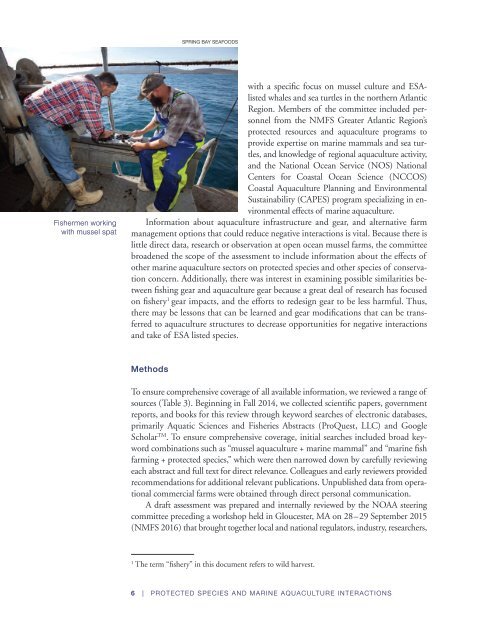Protected Species and Marine Aquaculture Interactions
x9Jh2
x9Jh2
Create successful ePaper yourself
Turn your PDF publications into a flip-book with our unique Google optimized e-Paper software.
SPRING BAY SEAFOODS<br />
Fishermen working<br />
with mussel spat<br />
with a specific focus on mussel culture <strong>and</strong> ESAlisted<br />
whales <strong>and</strong> sea turtles in the northern Atlantic<br />
Region. Members of the committee included personnel<br />
from the NMFS Greater Atlantic Region’s<br />
protected resources <strong>and</strong> aquaculture programs to<br />
provide expertise on marine mammals <strong>and</strong> sea turtles,<br />
<strong>and</strong> knowledge of regional aquaculture activity,<br />
<strong>and</strong> the National Ocean Service (NOS) National<br />
Centers for Coastal Ocean Science (NCCOS)<br />
Coastal <strong>Aquaculture</strong> Planning <strong>and</strong> Environmental<br />
Sustainability (CAPES) program specializing in environmental<br />
effects of marine aquaculture.<br />
Information about aquaculture infrastructure <strong>and</strong> gear, <strong>and</strong> alternative farm<br />
management options that could reduce negative interactions is vital. Because there is<br />
little direct data, research or observation at open ocean mussel farms, the committee<br />
broadened the scope of the assessment to include information about the effects of<br />
other marine aquaculture sectors on protected species <strong>and</strong> other species of conservation<br />
concern. Additionally, there was interest in examining possible similarities between<br />
fishing gear <strong>and</strong> aquaculture gear because a great deal of research has focused<br />
on fishery 1 gear impacts, <strong>and</strong> the efforts to redesign gear to be less harmful. Thus,<br />
there may be lessons that can be learned <strong>and</strong> gear modifications that can be transferred<br />
to aquaculture structures to decrease opportunities for negative interactions<br />
<strong>and</strong> take of ESA listed species.<br />
Methods<br />
To ensure comprehensive coverage of all available information, we reviewed a range of<br />
sources (Table 3). Beginning in Fall 2014, we collected scientific papers, government<br />
reports, <strong>and</strong> books for this review through keyword searches of electronic databases,<br />
primarily Aquatic Sciences <strong>and</strong> Fisheries Abstracts (ProQuest, LLC) <strong>and</strong> Google<br />
Scholar TM . To ensure comprehensive coverage, initial searches included broad keyword<br />
combinations such as “mussel aquaculture + marine mammal” <strong>and</strong> “marine fish<br />
farming + protected species,” which were then narrowed down by carefully reviewing<br />
each abstract <strong>and</strong> full text for direct relevance. Colleagues <strong>and</strong> early reviewers provided<br />
recommendations for additional relevant publications. Unpublished data from operational<br />
commercial farms were obtained through direct personal communication.<br />
A draft assessment was prepared <strong>and</strong> internally reviewed by the NOAA steering<br />
committee preceding a workshop held in Gloucester, MA on 28– 29 September 2015<br />
(NMFS 2016) that brought together local <strong>and</strong> national regulators, industry, researchers,<br />
1<br />
The term “fishery” in this document refers to wild harvest.<br />
6 | ProtEctEd SPEciES <strong>and</strong> MarinE aquaculturE intEractionS


